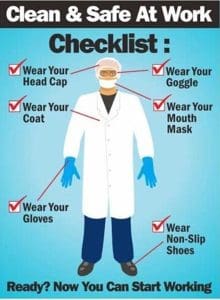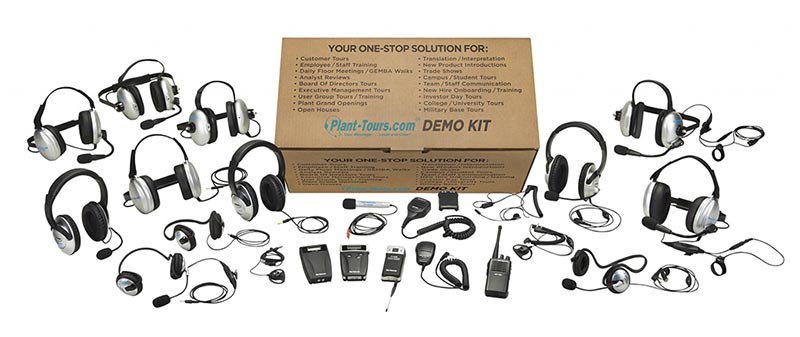Tips for Food Safety in Manufacturing
Today, there are more monthly news headlines about contaminated food products, food recalls, and people who find foreign objects in processed foods. It’s possible to prevent problems in the food manufacturing industry with a better food safety program and tighter observation of people performing processing tasks. Learning from the mistakes of other entities, new production facilities can use those lessons to do better and strive to become leaders in the food industry.
When it comes to food production facilities, the safety of products must be a factor that is incorporated into every facet of internal procedures, policies, and strategies. Because contaminated, spoiled, or dangerous food products can lead to many expensive problems, it is essential to maintain a detailed food safety management system.
Good manufacturing practices (GMP) and additional safety measures can help prevent contamination from various sources. Processing incoming supplies, packing finished products into shipping boxes, and all other phases of the production process come with risks that must be mitigated. These are important issues to consider whether you just opened a food production plant or are considering opening one.
Correct Machines
Today, manufacturers have a greater demand to increase productivity, output, and quality. To do this, they must keep up with changes in machinery, digitalization, and other trends that improve outcomes. Research shows that overall equipment effectiveness should be at 85% but is often between 50% and 60% for manufacturing companies. Single-machine failure from improper use is also a common problem that has ripple effects throughout the facility and can negatively impact productivity, output, and quality.
For employees to use machines correctly, they must have thorough food safety in manufacturing training for specific machines. Misusing the right machines can lead to multiple safety hazards. After employees receive training, test their knowledge to ensure that initial training is sufficient. If not, it must be adjusted. Additionally, extra training when there are new developments is essential. Reviewing procedures periodically can also reduce risks by ensuring that employees do not forget important safety information. Employers should also place critical safety tips in different work sections.
Not using the correct type of machinery can also have adverse safety outcomes. For example, sometimes, it is necessary to choose a type of machinery to process a product after its initial production steps. When this happens, modern technology and methods can help. Research shows that hardware-level communication between two ADC channels can help determine the correct machines in the next steps of production based on the color or size of food items.
Process for Cleaning Components
Many risks jeopardize food safety when it comes to machine components. It is important to follow proper cleaning procedures for every piece of equipment and each area. Doing this can help mitigate most risks. For example, combustible dust can be a hazard from improper cleaning. The NFPA and OSHA have several requirements for minimizing this dust, and both apply to food manufacturing plants.
Facilities must test for combustible dust. If a facility has it, the workers must use the right filters and implement specific types of safe cleaning systems. In this example, it is critical to have the right process for cleaning components and areas to avoid serious problems. Perform regular equipment risk assessments to identify other improvements in the cleaning plan. Be sure to follow all regulations and machine manufacturer instructions for cleaning.
Machine Maintenance
Machine maintenance must address microbiological risks and foreign object risks. While regular maintenance ensures that machines keep functioning properly, it can also uncover potential contamination sources. For example, one crucial part of machine maintenance that may be overlooked is welding. Machine parts needing welding can create risks of loose foreign objects or bacteria growth without it. If a machine has small crevices in parts that come into contact with food, those crevices can collect residue and bacteria. That residue may come loose in food processing and contaminate products. Also, machine parts can chip or lose screws.
Inspect machinery for burrs, sharps, or small pieces that could break. Look at the surfaces to see if there are concave areas that should be welded. Attached parts, threaded screws, and cracks between welded joints are additional areas that can harbor bacteria or debris. Take corrective actions immediately if any other risks related to loose metal objects exist.
Prioritize Sanitization
Food plants should review sanitation procedures to avoid food recalls. During the COVID-19 pandemic, many food production facilities in the country invested in sanitation initiatives. Today, research shows that their investments paid off. In a survey about difficulties in preventive control management in food manufacturing, 14% of respondents said that lack of sanitation was a critical factor that created more problems. This was a decrease from 20% in 2021.
In addition to limiting the risks of harmful microorganisms or pathogens in food, it can reduce the spread of illness among workers. Prioritizing sanitation may mean fewer sick days and improved productivity.
How does Contamination happen?
Contamination can happen before, during, and after steps in food production. For example, a food supply that arrives from a provider in the supply chain may already be contaminated.
Workers with poor personal hygiene on the production line may contaminate food. The same goes for inspected foods that pass quality checks.
What can you do about it?
It helps analyze and document every part of the process. Take note of chemicals, materials, temperatures, and all other factors that could potentially contribute to contamination through food contact.
A complete hazard analysis may reveal multiple problems. For example, there may be pests that signal the need for better pest control and the use of pesticides in some areas. However, proper use of pesticides is essential to prevent contaminating food.
Employees must have the proper training for required hygiene practices. They must learn about:
- Food contamination risks on the production line;
- Their roles in mitigating food contamination risks;
- Safe food handling procedures;
Employers, on the other hand, must provide them with the necessary equipment to perform their roles safely, such as:
- Gloves;
- Hair nets;
- Aprons;
- Other mandatory protective equipment.
Implementing and encouraging a strong food safety culture in the workplace helps everyone feel more invested in combating food safety risks. When workers see that their well-being is valued along with food safety, workplaces tend to have more favorable safety outcomes.
Consider the risk of cross-contamination
Another important sanitation factor to consider outside each station and process is the risk of cross-contamination. To produce safe food, facilities must ensure that foods are not transported across flow paths that put them at risk for contamination. For example, foods with allergens should not cross flow paths with stations for allergen-free processes. Also, raw materials should not cross transport paths with finished products. Contamination from raw materials can lead to foodborne illness.
Those are a few key points to consider. When analyzing and revising a sanitation plan, consider all the guidelines in Title 21 of the Code of Federal Regulations from the FDA.
Clear Communication
Communication between different departments and levels is vital to ensure safety. Does your team have clear and effective communication in their day-to-day? Food manufacturing facilities can be noisy. This kind of environment poses a threat to communication between teams and individuals.
Using high-noise two-way headsets for communication can help ensure that employees can communicate at any moment without interruptions.
Remember that, although verbal communication is helpful, critical messages should also be shared in written form.
Another overlooked factor is how employees can report issues that pose food safety risks. Food companies do not always clarify reporting procedures, and some employees may worry about the traceability of their complaints. This is especially true if the report involves a coworker who is not following food safety standards.
 Encourage workers to report unsafe situations
Encourage workers to report unsafe situations
One key message to convey to workers is that they have a legal right to report unsafe working conditions or hazards without fear of retaliation. This is a standard that OSHA protects. While communicating this to them may encourage some people to report risks, it also helps to offer incentives. For instance, workers who report serious food safety hazards may receive a gift card, an extra day of vacation time, or some other motivation. This also helps strengthen a workplace food safety culture. Good communication also goes beyond worker reports. Make sure there are clear procedures for record-keeping for dealing with reported issues and ongoing monitoring. Every worker and manager should understand their role in communicating to promote food safety.
Quality Check
Additional quality checks can often prevent public health risks that lead to product recalls. GMPs address quality and safety. However, food plants can create Hazard Analysis, and Critical Control Point plans to take quality assurance to a new level at the most critical control points. The HACCP team should include experts in production, engineering, quality assurance, sanitation, and microbiology of food. This often involves collaborating with third parties or outside experts. However, the improved food safety outcomes are worth the investment. As another part of a food safety culture, quality control with more steps and accountability can help significantly reduce food safety risks.
As you analyze and improve a food safety strategy for your facility, consider and incorporate ISO 22000 standards, the Food Safety Modernization Act’s applicable standards, and all other rules that apply to safety in food manufacturing.









